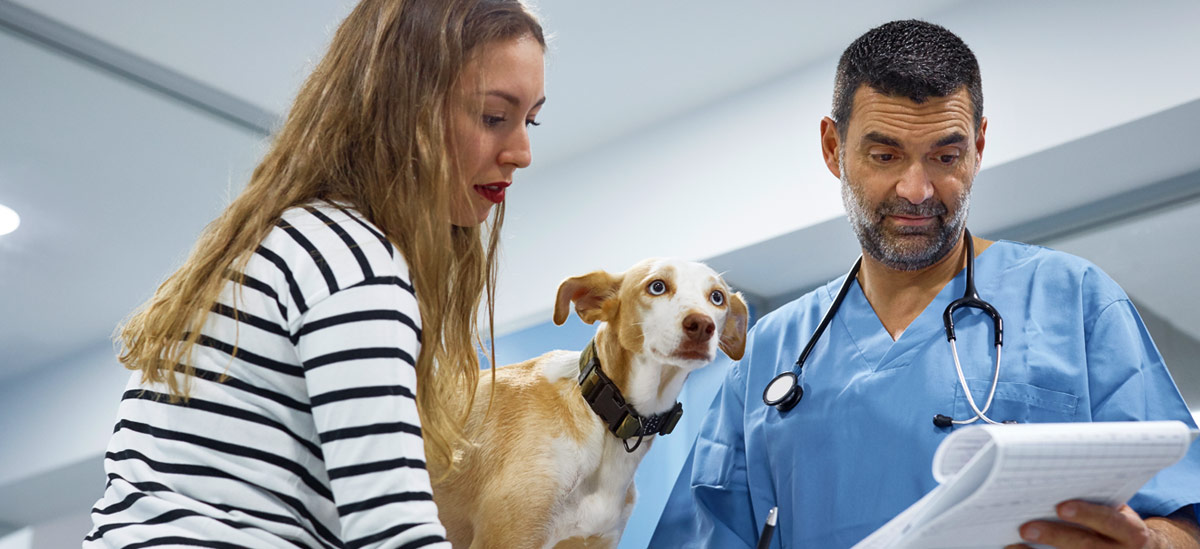
Pet care is healthcare and, when it comes to helping veterinary clients, PNC Bank’s healthcare financial pros offer all kinds of solutions. Whether it’s helping to resolve cash flow issues, aid with equipment financing, offer collections support, or make that new building purchase possible, we have a long track record as partners in many a veterinarian’s success.
But, even so, one avenue to increasing a practice’s financial strength is a simple recommendation any veterinarian can make to his or her clients: pet insurance.
The problem is an age-old one for veterinarians: When major health issues arise, owners must often choose between the health of the pet or the family finances. It’s a dilemma Henvil Grant, DVM, owner of Coral Sands Animal Hospital in Decatur, Georgia, has seen many times.
“I love animals. That’s why I became a vet. No vet wants to euthanize an animal because the client can’t afford more extensive care. Either that, or depending on the client’s finances or the situation, we as vets will be forced to give the patient a less effective procedure--or we’re forced to heavily discount our services.”
With an average emergency exam costing between $100-$200, and an overnight stay averaging from $1,000-$2,000, advanced care can prove a serious hardship to many. But when owners have a pet insurance policy in place, pets receive the care they need—and vets the revenue they deserve.
Better Care, Better Revenue
Pet insurance offers a win-win for pets, pet owners, and veterinarians alike. Nick Spanakis, head of PNC Bank’s healthcare business banking, explains how.
“All veterinarians feel the pressure to provide the best treatment, yet they need to improve cash flow and create better profitability. When advising clients, we always note how pet insurance makes a procedure or treatment once off the table now an option.”
Dan Walden is a PNC Bank healthcare relationship manager who specializes in serving veterinary practices. Walden helps his clients with a wide range of financial products, services, and expertise. He sees the business benefits of pet insurance every day, both with his veterinary clients and keeping his nine—yes, nine—Pomeranians healthy.
“During the COVID-19 pandemic, there was a huge upsurge in the number of pets. That’s a lot of new pets needing ongoing care. No matter your income, pet insurance allows you to and receive affordable care for your pet, no matter what. While pet insurance serves as a financial backstop, pet owners can explore the right treatments for their pets – regardless of pricing – which also enables vets to provide their best care.”
How Does Pet Insurance Work?
In many ways, insurance for pets works the same way it does for humans. Depending on the terms of the plan, pet insurance covers expensive procedures either wholly or in part.
At the same time, the insurance premium for one pet may be different than for the pet next door. According to Spanakis, “Just as people pay different health insurance costs depending on medical history, age, occupation, and a host of other factors, the premiums for individual pets can vary considerably.” As a result, premiums for pet insurance may vary based on:
- Species. As one example, dogs typically have more claims submitted for care than cats;
- Breed. There are some breeds that will be more prone to certain illnesses and injuries;
- Gender. Statistics show that male animals result in more claims than females;
- Age. As a pet gets older, the more care is needed, resulting in more costly premiums; and
- Area. Based on claims, insurance costs more for pet owners in major cities than in suburban or rural areas.[1]
One principal difference, however, is how claims are filed. As Walden points out, “While some pet insurance reimburses the veterinarian directly, most require the client to pay up front to the vet for services. Then, after payment, the pet owner sends the invoice to the insurer for reimbursement. As a consumer, I’m using my credit card, getting points and maximizing my rewards”
Dr. Grant agrees it’s a concept that continues to gain popularity with his clients.
“Pet insurance has become so commonplace that my clients ask if I take insurance even as they make the appointment. Further, because the patient is doing all the work making the claim--and not my staff--it’s really an easy recommendation for us to make and it doesn’t take time away from our day-to-day responsibilities.”
With dozens of insurance plans on the market, pet owners have a wealth of choices. The only function the veterinarian needs to perform is making the information available. That’s where visibility works wonders.
“In our clinic, we display brochures for several pet insurance carriers. We are very careful to mention that there are several companies on the market, and we don’t recommend any specific insurers. Instead, that client must do his or her due diligence and make their own choices. But encouraging our clients to investigate pet insurance allows someone like me to do more of what I like to do, which is to help animals.”
At PNC Bank, our healthcare team is constantly helping clients find new ways to succeed. When it comes to vet practices, pet insurance can make better treatment options available to a wider clientele.
The fact that pet insurance fetches better revenue and profitability for veterinarian clients just makes a good idea even better.




